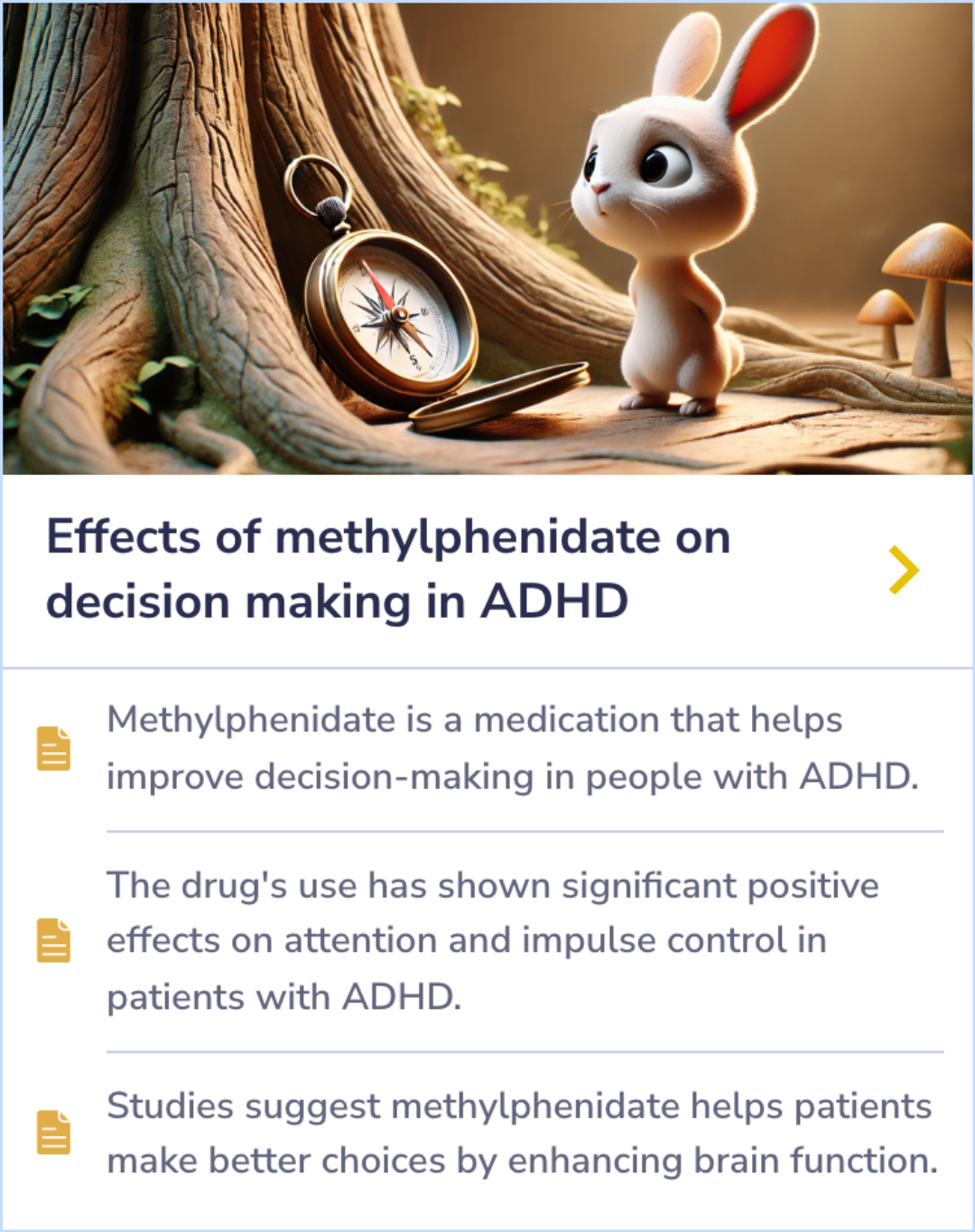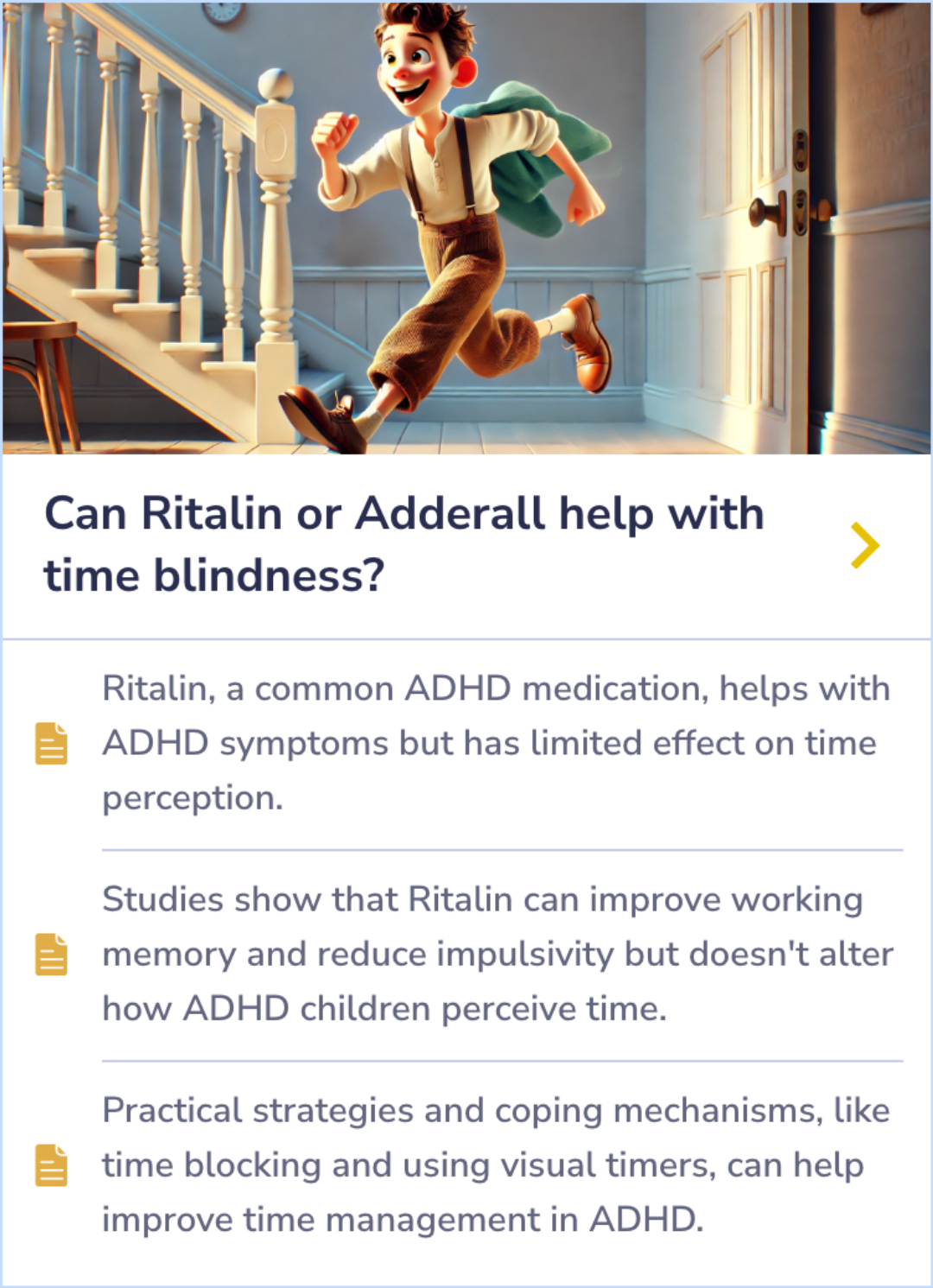Ritalin
Evidence Based Answers
4 Studies on the misuse of methylphenidate (Ritalin/Concerta)
Ritalin's effectiveness varies among adults over time, with some experiencing cognitive benefits while others face mild side effects.
Published: October 25, 2024
Click to explore a section:

The long-term effects of methylphenidate show variable effectiveness, common mild side effects, and potential cognitive improvements, highlighting individual responses.
Studies Summary
🎓
Risky Behaviors Linked to Methylphenidate Misuse
A study of college students showed that those who misused methylphenidate, like Ritalin or Concerta, were more likely to engage in risky behaviors, such as increased alcohol and drug use. They also faced more negative consequences compared to students who did not misuse these stimulants.
⚠️
Cardiovascular Risks from Co-Use with MDMA
Research on the combined use of methylphenidate and MDMA found increased risks, particularly related to heart health, despite no enhancement in psychoactive effects. The individual effects of each drug were not amplified, but the health risks were heightened.
🧠
Dopamine Blockage and Misuse Potential
Methylphenidate boosts dopamine in the brain by blocking transporters, leading to a euphoric sensation when misused. Misuse often involves routes like injection or snorting, which enhance its effects and increase abuse potential.
Highly Cited Studies
Long term Effects of Methylphenidate in Adults
Peer Reviewed Study 1
Link Between Ritalin/Concerta Misuse and Risky Behaviors in College
Peer Reviewed Study 2
Methylphenidate and MDMA Co-Use: Implications for Misuse
Peer Reviewed Study 3
Ethanol's Influence on Methylphenidate Misuse
Peer Reviewed Study 4
Methylphenidate's Impact on Brain Dopamine in ADHD
Background: Mechanism Behind Methylphenidate Misuse
Methylphenidate, also known as Ritalin or Concerta, is a central nervous system stimulant primarily used to treat ADHD. It increases dopamine levels in the brain by blocking dopamine transporters, which can lead to a sensation of euphoria when misused.
Misuse often involves non-therapeutic routes of administration, such as intravenous injection or snorting, which significantly amplifies the drug's euphoric effects.
Misuse often involves non-therapeutic routes of administration, such as intravenous injection or snorting, which significantly amplifies the drug's euphoric effects.
“
Source Quotes:
Methylphenidate binds to the dopamine transporter in the presynaptic cell membrane, blocking reuptake of dopamine and causing a resultant increase in extracellular dopamine levels.
Methylphenidate increases dopamine by blocking dopamine transporters, which is thought to underlie the reinforcing effects of drugs of abuse.
Background: Routes of Administration and Increased Abuse Potential
Methylphenidate is usually prescribed in oral form for medical use, but it can be misused through other methods that enhance its effects. Misusers may inject the drug intravenously or snort it, leading to a quicker and more intense euphoria compared to oral ingestion.
This alteration in administration greatly increases the drug's abuse potential.
This alteration in administration greatly increases the drug's abuse potential.
“
Source Quotes:
For medical purposes, methylphenidate is mainly given orally... Those who misuse methylphenidate for recreational purposes prefer to use the intravenous (IV) or the intranasal route.
When abused, methylphenidate is usually administered intranasally or injected intravenously.
Background: Comparing Methylphenidate with Other Stimulants
Methylphenidate shares similarities with other stimulants like amphetamines and cocaine, particularly in how it affects dopamine levels in the brain. Despite these similarities, the abuse potential of methylphenidate is generally considered lower due to differences in how the drugs act on the brain.
“
Source Quotes:
Methylphenidate has a much lower abuse potential than cocaine, possibly related to other pharmacological differences between the two drugs.
Despite their similarities, there is evidence that the effects of amphetamine and methylphenidate differ... suggesting a higher reinforcing efficacy for D-amphetamine.
Background: Health Risks of Long-Term Methylphenidate Misuse
Long-term misuse of methylphenidate can lead to various health complications, including tolerance, psychological dependence, and adverse effects like growth suppression, cardiovascular issues, and psychiatric symptoms.
Chronic misuse, especially at high doses or through non-oral routes, can result in severe psychological effects, including psychosis.
Chronic misuse, especially at high doses or through non-oral routes, can result in severe psychological effects, including psychosis.
“
Source Quotes:
Chronic abusive use can lead to marked tolerance and psychological dependence with varying degrees of abnormal behavior.
Psychosis has been reported in individuals who misuse or take excessive amounts of stimulant medication... Otherwise, psychosis appears to be rare in clinical samples of adults with ADHD receiving stimulant treatment.
Background: Impact of Methylphenidate on Growth and Development
Methylphenidate misuse can significantly affect growth and development, particularly in children. Prolonged use of the drug has been linked to growth suppression, resulting in reduced height and weight over time.
The stimulant properties of methylphenidate may interfere with normal growth patterns.
The stimulant properties of methylphenidate may interfere with normal growth patterns.
“
Source Quotes:
Long-term suppression of growth: Careful follow-up of weight and height in children... suggests that consistently medicated children have a temporary slowing in growth rate.
Methylphenidate has demonstrated growth suppression when used daily, long-term.
Peer Reviewed Study
Study: Link Between Ritalin/Concerta Misuse and Risky Behaviors in College
This study surveyed 2,250 undergraduate students at a large university, finding that 3% reported illicit use of methylphenidate (Ritalin/Concerta) in the past year. Those who misused these stimulants were more likely to engage in risky behaviors, such as frequent alcohol and drug use, and faced more negative consequences compared to students who did not misuse stimulants.
Both male and female students reported similar rates of misuse, and weekly party behavior was a significant factor linked to illicit use.
Both male and female students reported similar rates of misuse, and weekly party behavior was a significant factor linked to illicit use.
author
Teter CJ, McCabe SE, Boyd CJ, Guthrie SK
journal
Pharmacotherapy
Date Published
May 2003
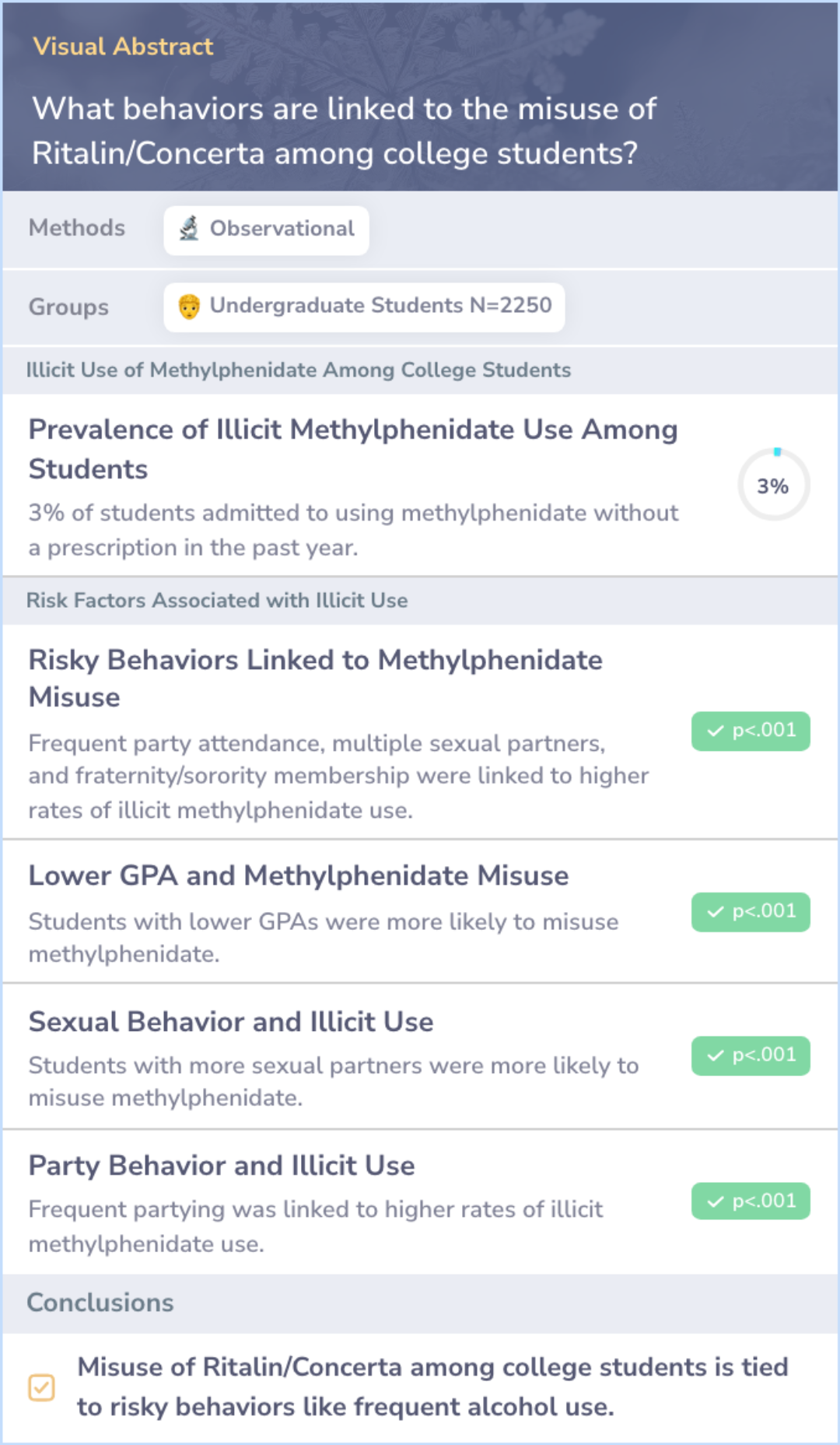
Peer Reviewed Study
Study: Methylphenidate and MDMA Co-Use: Implications for Misuse
This study explored the misuse of methylphenidate (Ritalin/Concerta) with MDMA (ecstasy). Both drugs impact brain chemicals like dopamine and norepinephrine, but in different ways. Although methylphenidate and MDMA can individually cause psychostimulant effects, their combined use does not enhance these effects further. However, it does increase cardiovascular risks and other adverse effects.
Despite shared subjective effects similar to amphetamines, MDMA improved mood more, while methylphenidate enhanced focus. Importantly, combining them did not change MDMA's effects on processing emotions or show any added psychoactive effects. Such findings highlight risks in the context of misusing methylphenidate.
Despite shared subjective effects similar to amphetamines, MDMA improved mood more, while methylphenidate enhanced focus. Importantly, combining them did not change MDMA's effects on processing emotions or show any added psychoactive effects. Such findings highlight risks in the context of misusing methylphenidate.
author
Hysek CM, Simmler LD, Schillinger N, Meyer N, Schmid Y, Donzelli M, Grouzmann E, Liechti ME
journal
Int J Neuropsychopharmacol
Date Published
2014 Mar
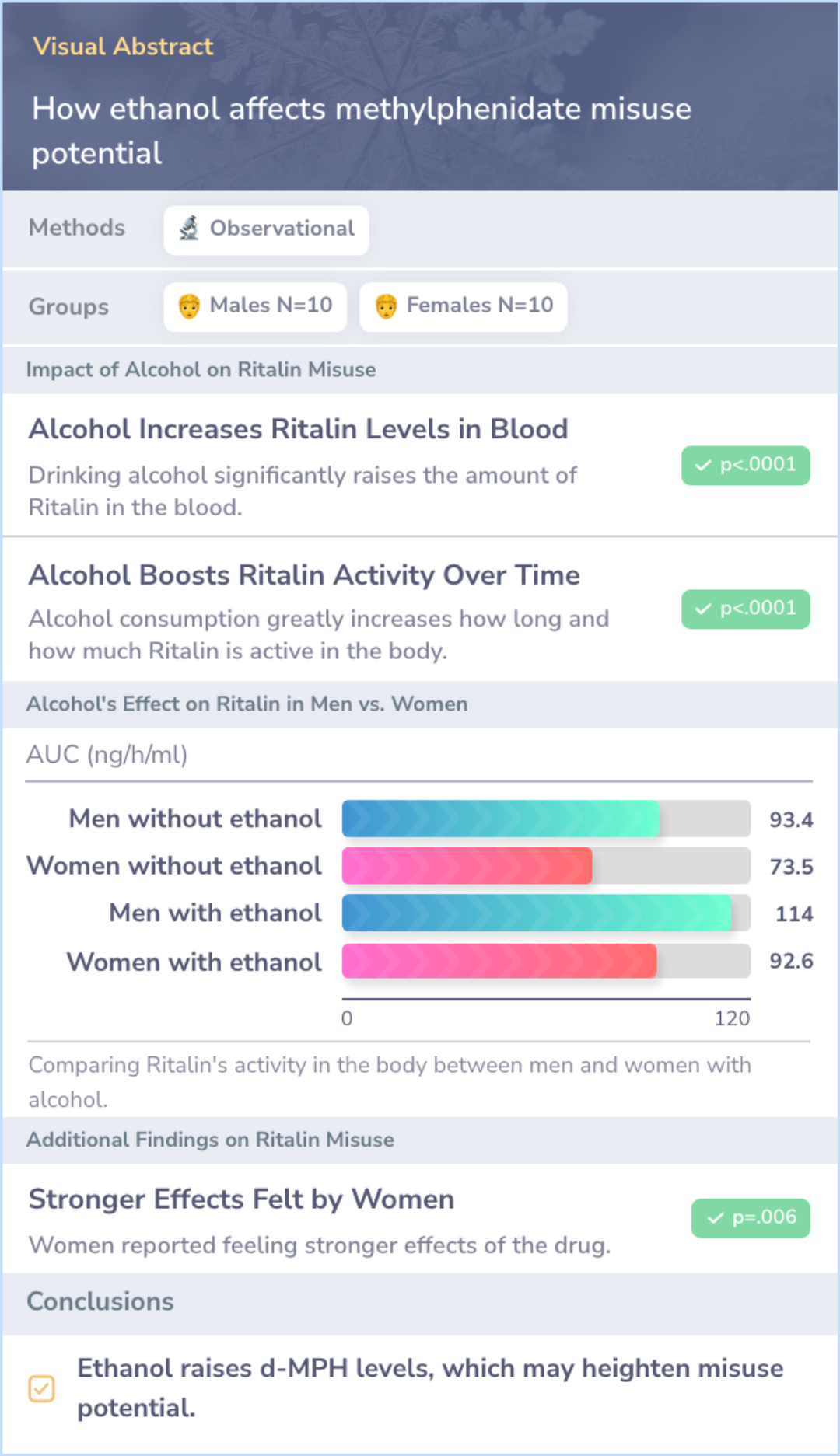
Peer Reviewed Study
Study: Ethanol's Influence on Methylphenidate Misuse
This study investigates how ethanol impacts the drug methylphenidate (MPH), commonly known for brands like Ritalin or Concerta. Ethanol was found to significantly increase the concentrations of d-MPH in the blood. This is important because higher drug levels might lead to increased misuse potential.
The study also noted differences between men and women. Women reported a stronger stimulant effect from the drug, even when they had lower drug levels in their blood compared to men. This could suggest different patterns of misuse potential between sexes.
The identification of a poor metabolizer, a person whose body handles the drug differently, could play a role in understanding individual risks of misuse. Exploring genetic causes of this metabolism difference could help tailor safer drug usage for such individuals.
The study also noted differences between men and women. Women reported a stronger stimulant effect from the drug, even when they had lower drug levels in their blood compared to men. This could suggest different patterns of misuse potential between sexes.
The identification of a poor metabolizer, a person whose body handles the drug differently, could play a role in understanding individual risks of misuse. Exploring genetic causes of this metabolism difference could help tailor safer drug usage for such individuals.
author
Patrick KS, Straughn AB, Minhinnett RR, Yeatts SD, Herrin AE, DeVane CL, Malcolm R, Janis GC, Markowitz JS
journal
Clin Pharmacol Ther
Date Published
2007 Mar

Peer Reviewed Study
Study: Methylphenidate's Impact on Brain Dopamine in ADHD
Methylphenidate, often prescribed for ADHD, blocks the dopamine transporter, potentially influencing dopamine levels. This study checked whether therapeutic doses affect dopamine in the brain. Researchers used a brain imaging method called positron emission tomography on 11 healthy individuals. Results showed that methylphenidate increased dopamine levels in the brain, suggesting it amplifies dopamine that's already released, enhancing task-focused signaling in ADHD.
The rise in dopamine is linked to improved attention and reduced distractions. These findings help explain how methylphenidate's therapeutic use could be effective.
The rise in dopamine is linked to improved attention and reduced distractions. These findings help explain how methylphenidate's therapeutic use could be effective.
author
Volkow ND, Wang G, Fowler JS, Logan J, Gerasimov M, Maynard L, Ding Y, Gatley SJ, Gifford A, Franceschi D
journal
J Neurosci
Date Published
2001 Jan 15

Key Takeaways
Conclusions
The misuse of methylphenidate (Ritalin/Concerta) presents significant risks and challenges, evidenced by numerous studies. College students misusing the drug often encounter hazardous behaviors, highlighting a concerning pattern between stimulant misuse and risky lifestyle choices. Furthermore, ethanol's influence exacerbates methylphenidate misuse potential, particularly in varying effects between genders.
Additionally, combining methylphenidate with substances like MDMA increases cardiovascular risks without additional benefits, emphasizing the dangers of poly-drug use. While therapeutic applications prove beneficial for ADHD, inappropriate routes of administration and long-term misuse lead to adverse effects such as cardiovascular issues, psychological dependence, and growth suppression.
Additionally, combining methylphenidate with substances like MDMA increases cardiovascular risks without additional benefits, emphasizing the dangers of poly-drug use. While therapeutic applications prove beneficial for ADHD, inappropriate routes of administration and long-term misuse lead to adverse effects such as cardiovascular issues, psychological dependence, and growth suppression.
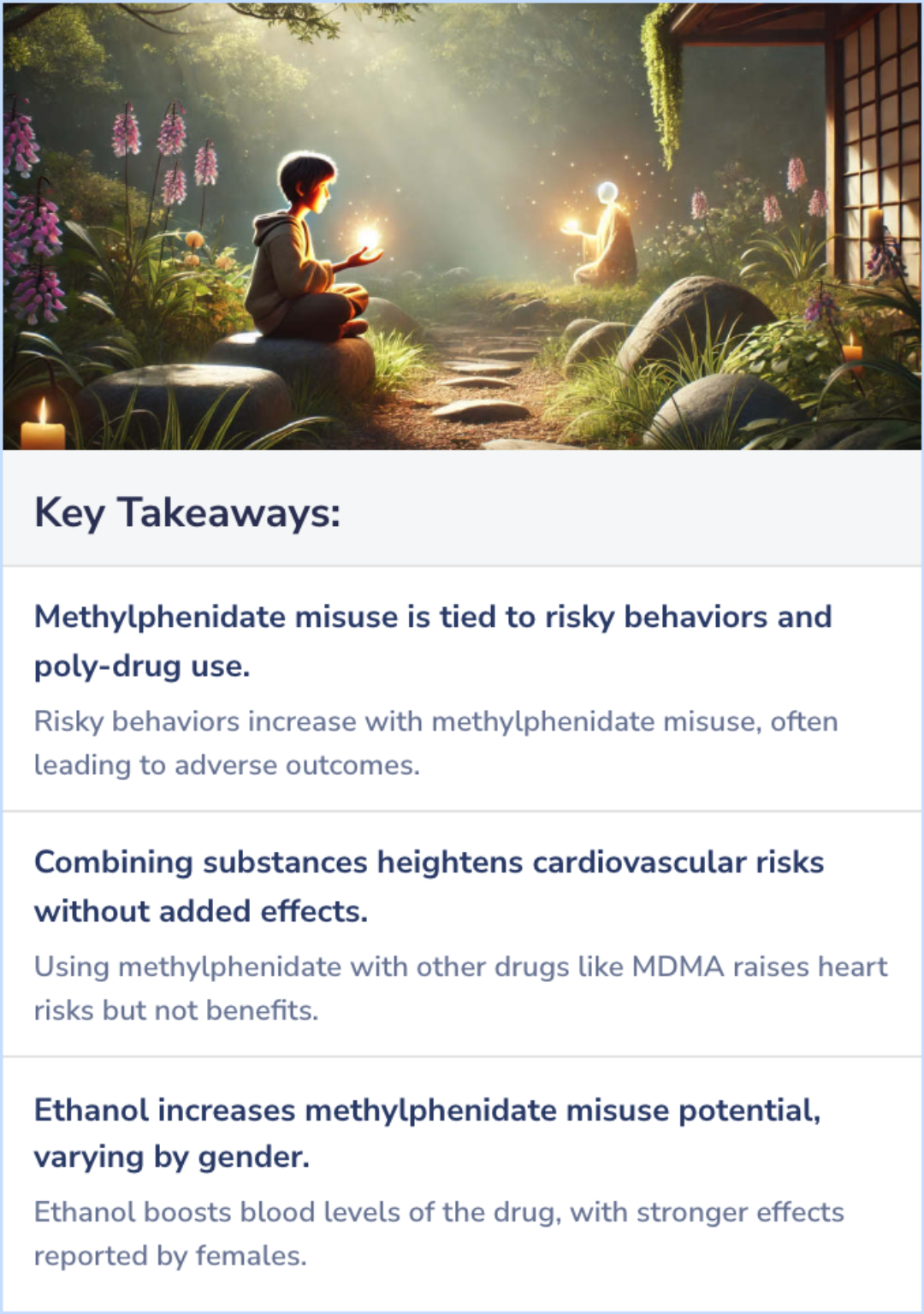
Evidence Summary
How Methylphenidate Shapes Brain Metabolism for ADHD Treatment
Methylphenidate, commonly known for treating ADHD, plays a role in how our brains use energy. By influencing brain metabolism, it helps improve focus and attention. This medication not only manages symptoms but aids in optimizing treatment plans. The drug's ability to modify energy usage in the brain showcases its potential to tailor ADHD treatments effectively.
Evidence Summary
Methylphenidate: From ADHD Treatment to Enhanced Decision-Making
Methylphenidate boosts decision-making by improving attention and impulse control in individuals with ADHD. Enhanced brain function from the medication makes for better choice-making. Studies back this, showing tangible positive outcomes in patients.
While the abstract discussed the misuse potential, here we see its therapeutic side: helping those with ADHD make thoughtful decisions by sharpening focus and reducing impulsivity.
While the abstract discussed the misuse potential, here we see its therapeutic side: helping those with ADHD make thoughtful decisions by sharpening focus and reducing impulsivity.
Evidence Summary
Ritalin Boosts Focus but Falls Short on Time Perception
Ritalin, used to treat ADHD, improves focus by aiding working memory and reducing impulsivity. However, its influence on how individuals with ADHD perceive time remains limited. Utilizing practical strategies like time blocking and visual timers can enhance time management.
Combining medication with these strategies supports more effective task handling, emphasizing the need for adaptable approaches in managing ADHD.
Combining medication with these strategies supports more effective task handling, emphasizing the need for adaptable approaches in managing ADHD.

